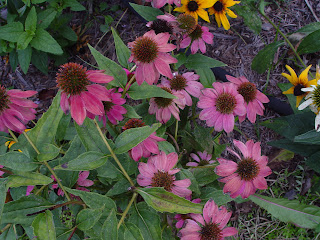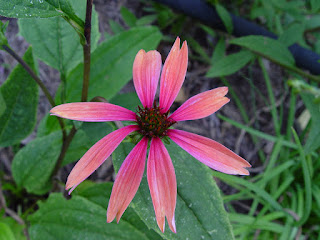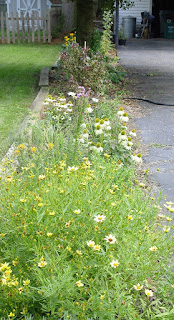Our local deer herd continues to grow, at least for now. Walking near the city wildlife refuge a few days ago, a glance at the side of the road revealed a smallish doe and two fawns, browsing the grass between the reserve and the street. It would not be fair to describe her as totally unconcerned (though a common description of the deer around here is "tame as dogs"), but she certainly wasn't particularly alarmed at my presence or that of a car turning out of a driveway across the street. The babies were a little more nervous, retreating into the shade of the trees as the car went past and I got closer.
I'm not sure about the health of this growing deer herd. This doe wasn't quite Scrawny Momma (the name we gave to a stray tabby who took up residence on our back deck at a previous house), but she certainly wasn't overweight. She was so small that her ears were her largest and most notable feature. Her ribs were more hinted at than visible, but they contrasted with the swollen udder that was obviously well-used. I had no idea that deer developed such visible udders, never having been this close to a nursing mother of that species before. She and I stood observing each other for a minute or two, at which point I decided that I really did need to get home, and she took a few steps away from the street into the protection of the posted refuge. The browsing of the new growth along the refuge edge continued.
About Me

- Rebecca
- I'm a woman entering "the third chapter" and fascinated by the journey.
Thursday, August 30, 2012
Monday, August 27, 2012
To wear the purple
I generally associate purple with spring and fall flowers, but a recent walk showed lots of purple happening in August. Some of it was found on the usual suspects, like ironweed
and liatris
and aster,
and a tiny flower that I still haven't identified.
But there was also purple in unexpected places, like the stems of milkweed and a shrub dogwood (red osier, maybe?).
Even the grasses were getting into the act, not only the aptly named purple lovegrass
And while it probably comes as no surprise to anyone that thistle blossoms are purple,
I have to confess to being astounded at the beauty of this common "weed" viewed up close and personal.
It's a good time to put a little purple in your world.
Tuesday, August 14, 2012
This week's visitors
I wish I were better at capturing animals in photographs; unfortunately, they're not as cooperative as plants about holding still. Perhaps my favorite photo-I-didn't-get was a chipmunk on the front stoop, practically nose-to-nose with Mirabel the Menace, in her youth the most mischievous of our cats. By the time the camera is out of its case, the creature is generally gone. Sigh.
We've had our share of wildlife this summer, not only the skunk that did pose for photographs and the chipmunk that didn't, but the fawn that exploded out of the meadow garden, Stumpy, our regular visitor, butterflies of all shapes and sizes, and the usual assortment of sparrows, finches, chickadees, titmice, cardinals, nuthatches, wrens, and woodpeckers. We also had what may have been our first hawk, perched on the feeder pole and surveying the yard (and of course, not catching anything that way). It may have been the same bird I saw a few blocks away later in the week: that time, the bird, possibly a juvenile red-tailed hawk, was standing in the middle of Plum Street, only flying away when I moved closer to get a better look. I suspect that an adult hawk with more experience would not have found the street a good place to look for food.
The front-yard liatris has proven to be a butterfly magnet, and butterfly brains (if they have them--Biology 101 was a LONG time ago) are so small that the insects don't seem to process me as potential danger. Of course, I'm much too large to be taken for a bird or a spider, so maybe butterflies are smarter than I'm giving them credit for.
This skipper (possibly a fiery skipper?) went about its business unconcernedly last evening, allowing me to snap several pictures.
 Squirrels are a different matter. If you look in the lower right corner of this photo, you will see a black squirrel running away.
Squirrels are a different matter. If you look in the lower right corner of this photo, you will see a black squirrel running away. Monday, August 13, 2012
The colors of August
I'm not a particularly good photographer, but August is a good month for color around here.
And this
zinnia and physocarpus
coreopsis "Red Shift," a white echinacea, and a deer-chomped liatris
 |
| agastache "Tutti Frutti" |
 |
| helenium and liatris |
 |
| wild ageratum (eupatorium coelestinum) |
gaillardia and aster "Purple Dome" (We go for gaudy sometimes.)
 |
| agastache "Tutti Frutti" and physocarpus "Coppertina" |
 |
| senescent echinacea of a forgotten variety |
 |
| echinacea "Sundown" |
is a baby one of these (yes, these blossoms are on the same zinnia plant at the same time).
I officially forgive June and July for all the heat.
Wednesday, August 8, 2012
Another happy ending
This morning as I was returning from putting laundry out to dry, there was a noise from the compost area, a fenced former dog run that also houses a nifty double rain-barrel setup crafted by my crafty spouse. It was the kind of noise that makes any bird-lover (or adult bird) take notice: the distress call of a (probably young) songbird. Investigating, I found a young robin (possibly the same adventurous juvenile stranded in the rhododendron a couple of days ago?) caught in some leftover bird netting that hadn't been put away after its last stint protecting some plant or other but tossed under the rain barrel frame. (Yes, I need to be more systematic about such things.)
This young turdus migratorius had managed to get a foot caught in the net and, in its struggles, create a huge knot of plastic netting that tied its toes together and caught the leg at the knee. (Do birds have knees? What do we call the joint that bends in the middle of a bird leg?) Attempting to tease the knots out quickly convinced me that this wasn't a good plan as I was all-too-able to imagine a broken leg or worse. Then: technology to the rescue!
A pair of scissors quickly cut enough plastic threads to free the bird's foot and leg, enabling it to scramble away as it still didn't seem to have the flying thing quite mastered. A quick look later in the day found no bird inside the fence, so this young robin seems to have survived another of the hazards of life in suburbia.
This young turdus migratorius had managed to get a foot caught in the net and, in its struggles, create a huge knot of plastic netting that tied its toes together and caught the leg at the knee. (Do birds have knees? What do we call the joint that bends in the middle of a bird leg?) Attempting to tease the knots out quickly convinced me that this wasn't a good plan as I was all-too-able to imagine a broken leg or worse. Then: technology to the rescue!
A pair of scissors quickly cut enough plastic threads to free the bird's foot and leg, enabling it to scramble away as it still didn't seem to have the flying thing quite mastered. A quick look later in the day found no bird inside the fence, so this young robin seems to have survived another of the hazards of life in suburbia.
Random delights
Developments of the last couple of days in the wildlife garden:
goldfinches harvesting seeds from the white echinacea
finches and sparrows dustbathing in the sand pit that was supposed to be a patch of white clover
tiny orange butterflies nectaring on the Joe Pye weed
the first blossom on "Wild Romance" aster!
goldfinches harvesting seeds from the white echinacea
finches and sparrows dustbathing in the sand pit that was supposed to be a patch of white clover
tiny orange butterflies nectaring on the Joe Pye weed
the first blossom on "Wild Romance" aster!
Tuesday, August 7, 2012
So far, so good
Yesterday found a juvenile robin on the ground at the edge of our meadow garden. Still in the speckles-and-eyebrows stage, this bird was definitely too young to be out of the nest, but it was very lively--the explosion it made out of the grass when it saw this large thing lumbering around startled me--and very vocal, cheeping at great volume for someone to get it out of its predicament.
Whenever a young creature like this shows up, my first reaction is always to want to DO something, but all the online advice regarding juvenile birds is to leave them alone unless immediate rescue from the jaws of a neighborhood feline is in order. In this case, an adult robin was issuing distress calls from the closest tree, so I assumed that a parent was on the job and would attempt to craft a solution. I was right.
Repairing to the porch with a book (Susan Fenimore Cooper's Rural Hours, a nineteenth-century nature journal, in case anyone needs a relaxing summer read) after dinner, I noticed an adult robin perched on the feeder pole with a cicada in its beak, scanning the yard. "Aha," thought I. "It must be looking for that baby," and it was, sort of.
Whenever a young creature like this shows up, my first reaction is always to want to DO something, but all the online advice regarding juvenile birds is to leave them alone unless immediate rescue from the jaws of a neighborhood feline is in order. In this case, an adult robin was issuing distress calls from the closest tree, so I assumed that a parent was on the job and would attempt to craft a solution. I was right.
Repairing to the porch with a book (Susan Fenimore Cooper's Rural Hours, a nineteenth-century nature journal, in case anyone needs a relaxing summer read) after dinner, I noticed an adult robin perched on the feeder pole with a cicada in its beak, scanning the yard. "Aha," thought I. "It must be looking for that baby," and it was, sort of.
 |
| Taken at 7:30 AM through a pet-resistant screen |
This parent robin was sneaky. The afternoon's adventurous middle-schooler (or whatever the avian equivalent of a twelve-year-old is) had found refuge in the ailing rhodendron next to the porch, a decrepit shrub with scrawny stems the same color as the feathers of a young robin, with lichens mimicking the colors of its speckles. I discovered its presence only when the adult robin perched on an outer branch, and the juvenile moved to take the cicada, a process repeated several times before dark. The adult would sometimes return to the feeder pole and fly away with its prey in its beak, whether because it had other young elsewhere (and given the profligate reproduction of robins, this is quite likely) or because it hoped to distract potential predators from this vulnerable offspring, I never discovered. But the young bird was fed and hidden for the night, pretending to be a fat rhodendron twig.
Given the number of predators (cats, raccoons, skunks, hawks, jays, crows, and probably more) in our neighborhood, the chances of any particular individual juvenile of a prey species surviving in such a situation are not great. As of 6:30 this morning, however, the little bird was still there, and I can hear it demanding food even as I type. If one or more of its parents survived the night, this one has a good chance of surviving to populate the yard with more robins.
11:00 AM update. The baby is gone--no corpse or feathers anywhere.
Monday, August 6, 2012
It's showtime!
While there is no doubt some disagreement on this matter, it is quite possible that August is the best month for wildflowers in southern Ohio and western West Virginia. Yes, the spring ephemerals are long gone and the wild roses are going, but the field flowers have come totally into their own, with some fall bloomers sneaking in early.
For anyone in our area with time for a country ramble, I highly recommend Route 50 between Albany and McArthur. The Joe-Pye weed is head-high and in full purple poofiness right now in every spot with enough sun, an assortment of tall and short yellow composites is throwing sunshine everywhere, the occasional deep-purple ironweed is showing up, and a few goldenrods think it's September already. Any roadside will probably bear a distinct resemblance to my favorite wildflower drive, so don't miss the show, which won't be available again for a year.
For anyone in our area with time for a country ramble, I highly recommend Route 50 between Albany and McArthur. The Joe-Pye weed is head-high and in full purple poofiness right now in every spot with enough sun, an assortment of tall and short yellow composites is throwing sunshine everywhere, the occasional deep-purple ironweed is showing up, and a few goldenrods think it's September already. Any roadside will probably bear a distinct resemblance to my favorite wildflower drive, so don't miss the show, which won't be available again for a year.
Thursday, August 2, 2012
Progress!
It should come as no surprise to readers of this blog (or to anyone who knows me at all) that I basically DESPISE lawns. While I admit that a swath of low-growing green is restful to the eye, especially given my (perhaps excessively) unrestrained gardening style, turfgrass has almost nothing going for it. It requires constant maintenance, generally with noisy, petroleum-guzzling, fume-spewing equipment, and frequent applications of water and fertilizer if it is to have any hope of remaining a restful (?) greensward in our Mid-Ohio Valley summers.
So--I am in the process of killing most of what remains of the lawn. The current plan is to keep a small patch of the front yard in mowed turfgrass to set off the more interesting plantings, but the rest will eventually be gone. Luckily, the back yard is attempting to revert to the Great Eastern Forest on its own, given the lack of success I have thus far had at creating a clover lawn out back. The clover did fine for months, but the late-June heat wave did in the transplanted patch, though the original clover that has taken over from the scraggly fescue has come back. The front yard, however, had--the dreaded Bermuda grass.
This is not the place to go on about how much I hate Bermuda grass, and why, but a sense of the depth of my feelings for this plant can be inferred from the fact that I covered one entire side of the front yard with black plastic and then buried it under several cubic yards of shredded hardwood in an attempt to convince the Bermuda to die. Most of it has.
So--I am in the process of killing most of what remains of the lawn. The current plan is to keep a small patch of the front yard in mowed turfgrass to set off the more interesting plantings, but the rest will eventually be gone. Luckily, the back yard is attempting to revert to the Great Eastern Forest on its own, given the lack of success I have thus far had at creating a clover lawn out back. The clover did fine for months, but the late-June heat wave did in the transplanted patch, though the original clover that has taken over from the scraggly fescue has come back. The front yard, however, had--the dreaded Bermuda grass.
This is not the place to go on about how much I hate Bermuda grass, and why, but a sense of the depth of my feelings for this plant can be inferred from the fact that I covered one entire side of the front yard with black plastic and then buried it under several cubic yards of shredded hardwood in an attempt to convince the Bermuda to die. Most of it has.
That side of the yard is slated to become a "savannah garden," a mini-grassland with a few short trees interspersed with the grasses and forbs. There are not yet pictures of all the plantings that have gone in, but here are a few teasers:
 |
Facing the neighbor, eupatorium rugosum "Chocolate" fronting a serviceberry. A hedge of native switchgrass will eventually form a screen near the property line.
|
 |
| Fronting the street, a selection of flowering perennials, mostly native cultivars. |
 |
| The big picture, facing the guest room |
More plantings have gone in, so stay tuned for pictures after the muhly grass blooms.
Wednesday, August 1, 2012
What happens when you kill a hedge
Faithful followers of this blog may remember that, last summer, we had a yew hedge lining the driveway taken out.
 While such a hedge looks innocuous enough, it really wasn't good for much of anything and required frequent upkeep, so... out it went!
While such a hedge looks innocuous enough, it really wasn't good for much of anything and required frequent upkeep, so... out it went!
The hedge was replaced with a mix of shrubs and mostly native perennials, which, not quite a year after planting, looks like this:
The butterflies and I are happy. At least some of the human neighbors are, too.
Subscribe to:
Comments (Atom)


















